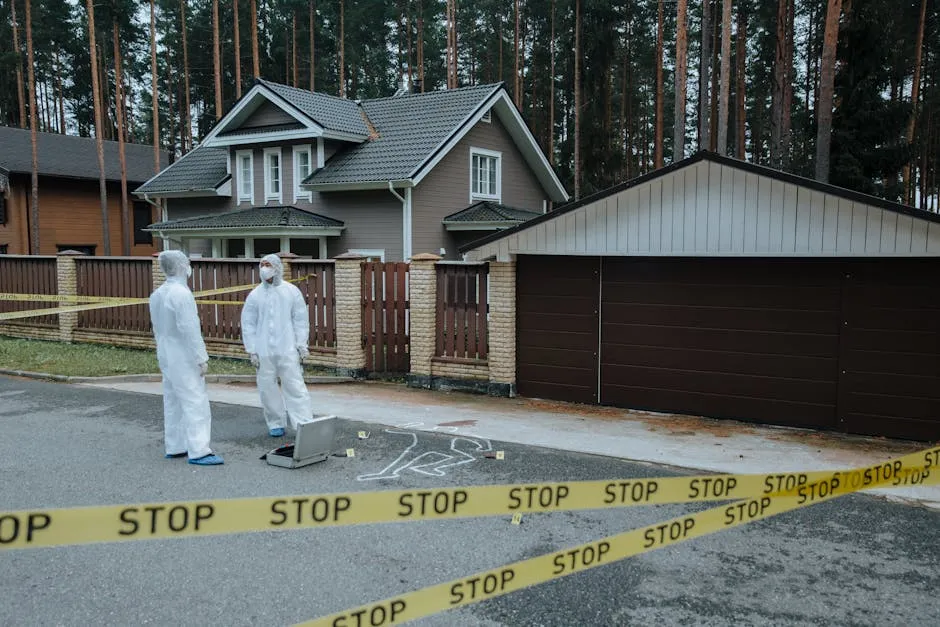Introduction
Crime statistics in Cleveland, Ohio, are a hot topic. Understanding these numbers is vital for everyone—residents, policymakers, and newcomers. After all, who doesn’t want to know if they’re moving into a crime hotspot or a cozy, safe neighborhood?
Cleveland’s overall crime rate is not just a little higher; it’s a whopping 155% above the national average. This statistic might sound like a plot twist in a crime drama, but it’s the reality for many living here. A city renowned for its vibrant culture and sports teams, Cleveland also grapples with significant safety challenges.
In this article, we’ll dive into the nitty-gritty of Cleveland’s crime statistics. We’ll analyze various trends, explore local perceptions, and discuss future initiatives aimed at improving safety. Get ready for a rollercoaster of numbers, insights, and perhaps a few surprising facts that may change how you view this city.

Understanding Crime Statistics in Cleveland
Overview of Crime Rates
Cleveland’s crime rate is staggering. To put it bluntly, it is 155% higher than the national average. This statistic encapsulates a city struggling with crime, particularly violent and property offenses. Violent crimes include assault, robbery, rape, and even murder. Property crimes cover theft, vehicle theft, and burglary.
Recent figures from 2022 paint a troubling picture:
- Total Violent Crimes: 5,870 incidents, translating to 1,614 per 100,000 residents. This figure is a jaw-dropping 336.4% above the national average.
- Total Property Crimes: 15,704 incidents, or 4,317 per 100,000 residents, which is 120.9% higher than the U.S. average.
To better understand the complexities of crime, consider diving into some thought-provoking literature. Books like The New Jim Crow by Michelle Alexander provide critical insights into systemic issues surrounding crime and punishment.

Detailed Crime Statistics
Let’s break these numbers down further. Below is a table comparing Cleveland’s crime statistics against national averages, focusing on incidents per 100,000 residents.
| Statistic | Cleveland (per 100k) | National (per 100k) |
|---|---|---|
| Total Crime | 5,931 | 2,324 |
| Murder | 40 | 6.3 |
| Rape | 124.5 | 40.0 |
| Robbery | 425.8 | 66.1 |
| Assault | 1,023.5 | 268.2 |
| Burglary | 825.8 | 269.8 |
| Theft | 2,399.4 | 1,401.9 |
| Vehicle Theft | 1,091.9 | 282.7 |
These statistics clearly illustrate the concerns surrounding community safety. The implications are stark: living in Cleveland means residents face a higher risk of both violent and property crimes. Understanding these statistics is crucial for anyone considering a move to the city.
To understand the implications of these statistics, it’s essential to explore Cleveland crime statistics.
In summary, Cleveland’s crime landscape presents challenges that demand attention. By examining these figures, we can better appreciate not only the realities of urban life in Cleveland but also the ongoing efforts to improve safety and security. For those looking for a gripping read on the psychology of crime, consider The Anatomy of Violence by Adrian Raine, which delves into the biological roots of criminal behavior.

Crime Trends Over Time
Year-over-Year Analysis
Cleveland’s crime rates have a story to tell. In recent years, the city has witnessed a mixed bag of crime trends. According to the latest statistics, overall crime rates decreased by 7% from last spring. However, this doesn’t mean that everything is sunshine and rainbows.
Violent crime, which includes assaults, robberies, rapes, and homicides, has seen a bright side with a 7.1% decrease. That’s good news, right? But before you start celebrating, let’s talk about property crime, which has increased by a notable 10.4%. This uptick in property crime is like finding a fly in your soup: unexpected and less than appetizing.
In concrete numbers, Cleveland reported 5,870 violent crimes in 2022, translating to a staggering 1,614 incidents per 100,000 residents. In contrast, property crimes soared to 15,704 incidents, or 4,317 per 100,000 residents. To put it in perspective, Cleveland’s violent crime rate is 336.4% above the national average, while property crime stands at 120.9% higher than the U.S. average.
These trends raise questions. Why the disparity? Economic conditions, community engagement, and law enforcement strategies play a crucial role in influencing these statistics. Increased police presence and community collaboration have contributed positively to reducing violent crimes. Yet, the rise in property crimes suggests that while the city is making strides, challenges remain, especially regarding burglary and theft, which are often tied to economic factors.
This is a great moment to consider personal safety tools. Having a Personal Alarm for Women can be a crucial step in ensuring safety, giving you peace of mind while navigating potentially risky environments.

Historical Context
Looking back over the past decade reveals a more intricate picture. Crime rates in Cleveland have fluctuated, but the general trend shows a reduction in violent crimes while property crimes have seen an uptick. This trend can be attributed to several factors, including economic conditions and law enforcement efforts.
For instance, the city’s poverty rate is a staggering 32%, significantly higher than the national average of 15.1%. Higher poverty levels often correlate with increased property crime due to economic desperation. On the flip side, law enforcement agencies have ramped up their efforts to combat violent crimes. Strategies like community policing and increased patrols have led to a decrease in violent incidents.
In the last decade, Cleveland has also faced various social challenges, including the opioid crisis and domestic violence issues, which have influenced crime rates. As we analyze these statistics, it becomes clear that the interplay of economic factors and community dynamics shapes Cleveland’s crime landscape.
Understanding these trends is vital for residents, local leaders, and potential newcomers. It highlights the importance of ongoing community engagement and efforts to address the root causes of crime. While Cleveland has made progress in reducing violent crime, the increase in property crime reminds us that there’s still work to be done. For those interested in understanding the broader implications of crime, The Better Angels of Our Nature by Steven Pinker is a fascinating read.

Local Perception of Crime
Public Sentiment
Perception often differs from reality, especially when it comes to crime. A recent survey conducted among 293 Cleveland residents revealed some eye-opening insights. Only 22% of respondents feel safe walking at night, while a staggering 78% believe there’s too much crime in their neighborhoods.
This disconnect between perception and actual crime statistics is fascinating. While violent crime rates have seen a decline, property crime is on the rise. Residents may feel the weight of the increase in thefts and burglaries more acutely in their daily lives.
Interestingly, the survey also explored how effective residents feel about law enforcement. While many acknowledged that police presence is visible, 38% expressed concerns about slow response times. This sentiment suggests that while the police are trying, residents feel there’s room for improvement in responsiveness and support.
Comparing these feelings with actual crime statistics shows a complex picture. Despite the decrease in violent crime, the heightened fear of property crime undoubtedly influences how residents perceive their safety. The stark contrast between actual data and public sentiment emphasizes the need for effective communication from law enforcement and community leaders.
In a city that’s working hard to improve safety, addressing these perceptions is just as important as tackling the statistics. Engaging with the community, fostering trust, and ensuring that residents feel heard can go a long way in changing the narrative around crime in Cleveland. If you’re looking to enhance your personal safety, consider investing in a Home Security Camera System to keep an eye on your surroundings.

Community Engagement and Law Enforcement
Community engagement is vital in crime prevention. When residents take an active role, crime rates can drop. Cleveland is no exception. Local initiatives encourage citizens to report suspicious activities and form neighborhood watch groups. This involvement can empower communities, making crime less appealing.
Law enforcement effectiveness hinges on community trust. A positive relationship between police and residents can lead to quicker responses and better crime-solving. However, public sentiment about police responsiveness is mixed. While many appreciate the visible police presence, some express concerns about slow response times during emergencies.
In neighborhoods where police are actively engaged, residents feel safer. Patrol officers who interact with the community can build rapport. Such efforts help reduce crime and foster a sense of security. And speaking of security, having a Self-Defense Keychain can provide peace of mind for those uncertain about their surroundings.

Crime by Neighborhood
Neighborhood Breakdown
Cleveland boasts over 36 neighborhoods, each with unique crime rates. Some areas are safer than others, often due to various factors, including community involvement and socioeconomic status.
For instance, Tremont, Kamm’s Corner, and Ohio City on the West Side are considered safer neighborhoods. These areas enjoy lower crime rates, thanks in part to community initiatives and active local organizations.
Conversely, neighborhoods like Industrial Valley, North Broadway, and Kinsmith are hotspots for crime. High rates of violent and property crimes plague these areas, largely attributed to socioeconomic challenges.
Statistics reveal that violent crime rates in Cleveland neighborhoods can be alarming. The city’s overall violent crime rate stands at 1,614 incidents per 100,000 residents. However, certain neighborhoods experience rates much higher than this average, highlighting the need for targeted crime reduction efforts. If you’re interested in understanding how crime affects different communities, consider reading The Crime Book: Big Ideas Simply Explained.

Factors Influencing Crime in Different Areas
Socioeconomic factors significantly influence crime rates across neighborhoods. High poverty rates often correlate with increased crime. In Cleveland, the poverty rate sits at a staggering 32%, far above the national average of 15.1%.
Limited access to quality education and job opportunities can foster an environment conducive to crime. Residents in economically disadvantaged neighborhoods may resort to crime out of desperation.
Moreover, educational opportunities play a crucial role in crime prevention. Areas with higher educational attainment tend to experience lower crime rates. Investment in local schools and educational programs can help address these disparities. For those interested in the impact of education on crime, consider reading The Body Keeps the Score by Bessel van der Kolk, which discusses the effects of trauma on individuals and communities.
Understanding these factors is essential for developing effective crime prevention strategies. By addressing the root causes of crime, Cleveland can work towards safer communities for all residents.
In conclusion, community engagement is critical to law enforcement’s success, and understanding neighborhood dynamics helps identify solutions to crime in Cleveland. As residents and officials collaborate, the potential for meaningful change becomes a tangible reality.

Potential Causes for Crime in Cleveland
Socioeconomic Factors
Crime rates in Cleveland are not just numbers; they stem from real-life struggles. A staggering 32% of Cleveland residents live in poverty, far above the national average of 15.1%. This economic strain is like a pressure cooker, simmering with frustration and desperation.
Poverty and unemployment create a breeding ground for crime. When people can’t find jobs, the temptation to turn to illegal activities increases. Imagine trying to support a family with no income—hard not to consider some less-than-legal options, right?
Housing costs also play a significant role. The average rent in Cleveland is around $735 per month, which may seem reasonable until you realize that many residents are fighting to make ends meet. When basic needs like food and shelter become a struggle, crime can appear as a quick fix. In neighborhoods where rentals are high and jobs are scarce, crime often lurks around the corner. To ensure you’re protected at home, consider investing in a Home Safe for Valuables for peace of mind.
Let’s not forget about education. Disparities in educational opportunities can limit job prospects. Without access to quality education, many young people see crime as their only option. A lack of resources in schools means fewer chances for youth to break the cycle of poverty.

Systemic Issues
Cleveland’s crime issues aren’t just about individual choices; they’re tied to systemic problems. Education disparities are rampant, and many children attend underfunded schools. When classrooms lack basic supplies, students suffer. This disconnection from quality education leads to a lack of opportunities later in life.
Community resources also play a crucial role. Many neighborhoods lack access to recreational programs or support systems. Imagine growing up with nowhere to turn for help or mentorship. Without positive outlets, young people may seek attention in negative ways.
The city’s infrastructure can exacerbate these issues. Poorly maintained neighborhoods often feel neglected, leading to a sense of hopelessness. When residents don’t feel invested in their community, crime can escalate.
In essence, the combination of high poverty rates, educational disparities, and lack of community resources creates an environment ripe for crime. Addressing these underlying issues is essential for creating a safer Cleveland. And for those who want to be prepared for emergencies, an Emergency Survival Kit can be a lifesaver.

Future Initiatives and Crime Reduction Efforts
Current and Proposed Strategies
Cleveland isn’t throwing in the towel despite its challenges. Local law enforcement and community organizations are stepping up with initiatives to tackle crime head-on. One notable effort is the Crime Gun Intelligence Center, designed to curb gun violence by analyzing crime data and identifying patterns. This proactive approach aims to keep dangerous weapons off the streets before they can cause harm.
Additionally, there’s a push for increased police recruitment. The Cleveland Police Academy is now training new officers to fill the gaps left by those who’ve departed from the force. With a higher police presence, the hope is to deter crime and foster a sense of safety within the community.
Community engagement is also crucial. Residents are encouraged to participate in neighborhood watch programs and report suspicious activities. This collaboration between law enforcement and citizens can create a stronger, unified front against crime.
The city acknowledges that effective crime reduction isn’t just about policing; it’s about building relationships and trust within the community. By working together, Cleveland can make strides toward a safer environment for all. And for those who want to keep track of their surroundings, a Smart Doorbell with Video can be a great addition to home security.

Community Involvement
Community involvement isn’t just a buzzword; it’s a lifeline for crime prevention. Residents play a pivotal role in shaping their neighborhoods. Engaged citizens who report suspicious activity can help law enforcement respond quicker.
Local organizations are also stepping up, offering resources and support to those in need. By providing mentorship programs and job training, these initiatives aim to break the cycle of crime and poverty. And for those looking to monitor their fitness as part of a healthy lifestyle, a Fitness Tracker for Health Monitoring can help you stay on top of your game.
In summary, Cleveland is actively working on multiple fronts to combat crime. From strategic law enforcement efforts to community engagement, the city is committed to creating a safer future. It’s a challenging journey, but with collective effort, there’s hope for positive change.

FAQs
What are the crime rates in Cleveland compared to other cities?
Cleveland’s crime rates are notably higher than many nearby cities. For instance, violent crime in Cleveland stands at 1,614 incidents per 100,000 residents, compared to 546 in Bakersfield, CA, and 370 nationally. Property crime follows a similar trend, with Cleveland reporting 4,317 incidents per 100,000 residents. In comparison, Aurora, CO, has 4,229 incidents. These figures illustrate the pressing safety concerns in Cleveland relative to other urban areas.
How can residents stay safe in Cleveland?
Residents can adopt practical safety tips to enhance their security. First, always be aware of your surroundings. Stay alert, especially in unfamiliar areas. Second, secure your home; install quality locks and consider a security system. Third, don’t hesitate to report suspicious activities to law enforcement. Lastly, joining local neighborhood watch programs fosters community ties and collective vigilance.
What resources are available for crime reporting in Cleveland?
Cleveland residents have various resources for reporting crime. The Cleveland Division of Police encourages community members to report incidents via their hotline. Additionally, the city’s website offers access to local crime maps and resources for crime prevention tips. Community organizations often provide support and guidance for those needing assistance navigating the reporting process.
What is being done to improve safety in Cleveland?
Cleveland is actively implementing several initiatives aimed at improving safety. The Crime Gun Intelligence Center focuses on preventing gun violence through data analysis and community collaboration. Law enforcement is also increasing police recruitment to enhance presence in neighborhoods. Furthermore, community engagement programs encourage residents to participate actively in crime prevention efforts, creating a united front against crime.
Please let us know what you think about our content by leaving a comment down below!
Thank you for reading till here 🙂
All images from Pexels




